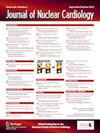The impact of obesity on myocardial flow reserve and its prognostic utility
IF 3
4区 医学
Q2 CARDIAC & CARDIOVASCULAR SYSTEMS
引用次数: 0
Abstract
Background
Obesity is a major cardiovascular risk factor associated with coronary microvascular dysfunction, which can be noninvasively assessed using myocardial flow reserve (MFR) on positron emission tomography (PET). As impaired MFR identifies high-risk patients, we assessed whether body mass index (BMI) modifies the association between MFR and cardiovascular outcomes.
Methods
Consecutive patients with no known coronary artery disease who had a clinically indicated PET were enrolled and followed prospectively for incident outcomes (all-cause death, major adverse cardiovascular events (MACE), and heart failure admissions). Multivariable-adjusted Cox proportional hazards models were used to study the association between MFR, and incident events stratified by BMI categories.
Results
The study population consisted of 3397 patients; median (IQR) age 67 (59-74) years, 55.2% female, 63.9% White, 17.6% with a BMI of 18.5-<25 kg/m2, 27.5% with a BMI of 25-<30 kg/m2, 38.6% with a BMI of 30-<40 kg/m2, and 16.3% with a BMI of ≥40 kg/m2. The median (IQR) MFR was 2.35 (1.96-2.80). Over a median (IQR) follow-up time of 1.34 (.43-2.43) years, there were 125 incident events (56 MACE, 6 HF admissions, and 70 deaths). In adjusted analyses, a .1-unit increase in MFR was significantly associated with decreased incident outcomes; HR (95% CI):0.91 (95% CI .84-.99) for BMI 18.5–<25 kg/m2, .88 (.83-.94) for BMI 25–<30 kg/m2, .93 (.87-.99) for BMI 30–<40 kg/m2, and .88 (.76-1.01) for BMI ≥40 kg/m2. There was no significant interaction between MFR and BMI; P = .381.
Conclusion
PET-derived global MFR is inversely associated with subsequent cardiovascular outcomes in all BMI categories.

肥胖对心肌血流储备的影响及其预后价值。
背景:肥胖是与冠状动脉微血管功能障碍相关的主要心血管危险因素,这可以通过正电子发射断层扫描(PET)上的心肌血流储备(MFR)进行无创评估。由于MFR受损可识别高风险患者,我们评估了体重指数(BMI)是否改变了MFR与心血管结局之间的关联。方法:连续招募无已知冠状动脉疾病但有临床指征PET的患者,并对事件结局(全因死亡、主要不良心血管事件(MACE)和心力衰竭入院)进行前瞻性随访。采用多变量校正Cox比例风险模型研究MFR与按BMI类别分层的事件事件之间的关系。结果:研究人群包括3397例患者;中位(IQR)年龄67(59-74)岁,55.2%为女性,63.9%为白人,17.6% BMI为18.5-2,27.5% BMI为25-2,38.6% BMI为30-2,16.3% BMI≥40 kg/m2。中位(IQR) MFR为2.35(1.96-2.80)。中位(IQR)随访时间为1.34(0.43-2.43)年,共发生125例事件(56例MACE, 6例HF入院,70例死亡)。在调整后的分析中,MFR每增加0.1个单位与事件结局的降低显著相关;相对危险度(95% CI): BMI 18.5-2为0.91 (95% CI 0.84-0.99), BMI 25-2为0.88 (0.83-0.94),BMI 30-2为0.93 (0.87-0.99),BMI≥40 kg/m2为0.88(0.76-1.01)。MFR与BMI之间无显著交互作用;p = 0.381。结论:在所有BMI类别中,pet衍生的总体MFR与随后的心血管结局呈负相关。
本文章由计算机程序翻译,如有差异,请以英文原文为准。
求助全文
约1分钟内获得全文
求助全文
来源期刊
CiteScore
5.30
自引率
20.80%
发文量
249
审稿时长
4-8 weeks
期刊介绍:
Journal of Nuclear Cardiology is the only journal in the world devoted to this dynamic and growing subspecialty. Physicians and technologists value the Journal not only for its peer-reviewed articles, but also for its timely discussions about the current and future role of nuclear cardiology. Original articles address all aspects of nuclear cardiology, including interpretation, diagnosis, imaging equipment, and use of radiopharmaceuticals. As the official publication of the American Society of Nuclear Cardiology, the Journal also brings readers the latest information emerging from the Society''s task forces and publishes guidelines and position papers as they are adopted.

 求助内容:
求助内容: 应助结果提醒方式:
应助结果提醒方式:


